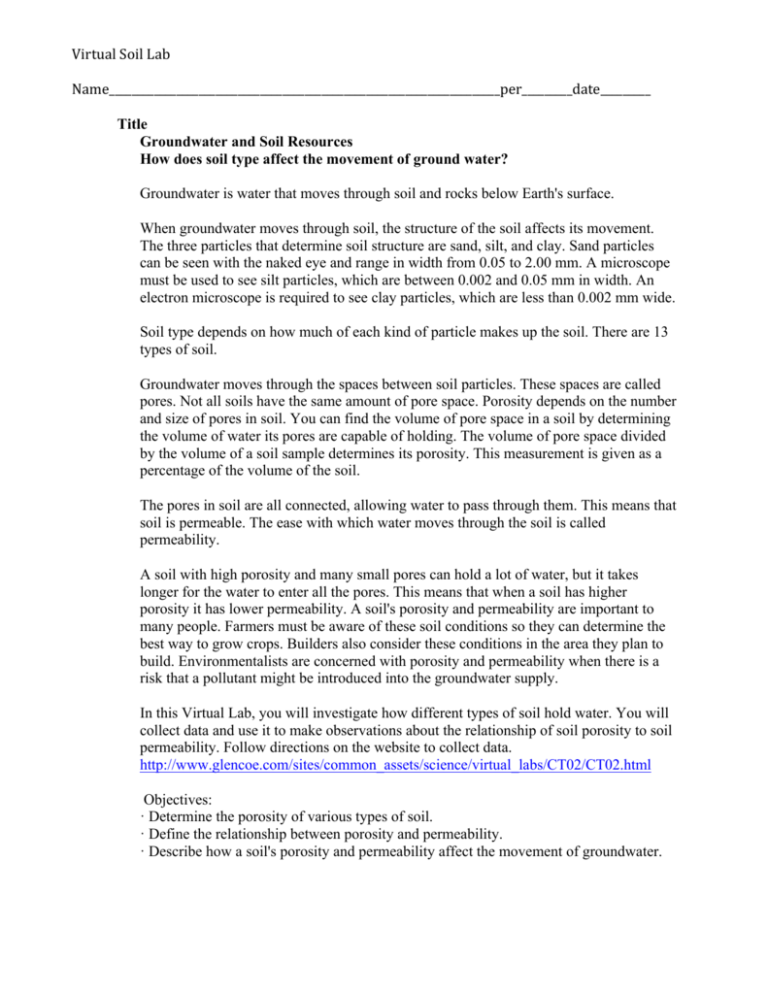Virtual Soil Lab
advertisement

Virtual Soil Lab Name______________________________________________________________________per_________date_________ Title Groundwater and Soil Resources How does soil type affect the movement of ground water? Groundwater is water that moves through soil and rocks below Earth's surface. When groundwater moves through soil, the structure of the soil affects its movement. The three particles that determine soil structure are sand, silt, and clay. Sand particles can be seen with the naked eye and range in width from 0.05 to 2.00 mm. A microscope must be used to see silt particles, which are between 0.002 and 0.05 mm in width. An electron microscope is required to see clay particles, which are less than 0.002 mm wide. Soil type depends on how much of each kind of particle makes up the soil. There are 13 types of soil. Groundwater moves through the spaces between soil particles. These spaces are called pores. Not all soils have the same amount of pore space. Porosity depends on the number and size of pores in soil. You can find the volume of pore space in a soil by determining the volume of water its pores are capable of holding. The volume of pore space divided by the volume of a soil sample determines its porosity. This measurement is given as a percentage of the volume of the soil. The pores in soil are all connected, allowing water to pass through them. This means that soil is permeable. The ease with which water moves through the soil is called permeability. A soil with high porosity and many small pores can hold a lot of water, but it takes longer for the water to enter all the pores. This means that when a soil has higher porosity it has lower permeability. A soil's porosity and permeability are important to many people. Farmers must be aware of these soil conditions so they can determine the best way to grow crops. Builders also consider these conditions in the area they plan to build. Environmentalists are concerned with porosity and permeability when there is a risk that a pollutant might be introduced into the groundwater supply. In this Virtual Lab, you will investigate how different types of soil hold water. You will collect data and use it to make observations about the relationship of soil porosity to soil permeability. Follow directions on the website to collect data. http://www.glencoe.com/sites/common_assets/science/virtual_labs/CT02/CT02.html Objectives: · Determine the porosity of various types of soil. · Define the relationship between porosity and permeability. · Describe how a soil's porosity and permeability affect the movement of groundwater. Virtual Soil Lab Name______________________________________________________________________per_________date_________ Collect data for each soil type and porosity and fill in the table below. Soil Type Sand Loamy Sand Sandy Loam Silt Silt Loam Loam Sandy Clay Loam Sandy Clay Sand Clay Loam Silt Clay Clay Heavy Clay Porosity (%) Answer these questions after completing the virtual lab. Use complete sentences in your answers. Restate the question in your answer. 1. What determines the texture of soil? 2. What is meant by the permeability of a soil? What is porosity and how is it related to permeability? 3. Based on your experiment, which type of soil is the most permeable? Which is the least permeable? How do you know? Virtual Soil Lab Name______________________________________________________________________per_________date_________ 4. Explain why surface runoff, or rain not absorbed by the soil, occurs much more often in areas with soils with a high clay content. 5. Soil type and texture are very important to farmers. Too little water in the soil may cause plants to wilt and die. Too much water in the soil can disrupt s plant’s ability to take in oxygen. Based on your data, which type of soil do you think is best for agriculture? Explain your answer. 6. Farmers often have problems with soil erosion when they clear their fields after the growing season. Soil type is one factor that influences erosion. Some soil types are more prone to the erosion than others. Based on the data you gathered in this experiment, which soil types do you think are the most easily eroded, soils with a high sand content or soils with a high clay content? Explain your answer.







